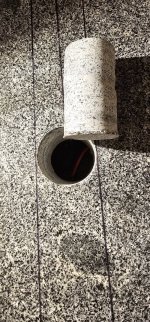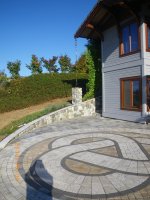If I can vouch for knowledge and experience here, I will go with SCD. I know the man and if I have something I have not done before (which is rare), I consult him before getting my feet wet. He is practical as you can read, and to this day has not steered me in the wrong direction.
To disagree with SCD likely means you know less than he does, including you 'geniuses' here.
To disagree with SCD likely means you know less than he does, including you 'geniuses' here.
Especially when there's fire involved. 😉I consult him before getting my feet wet.
jeff
Yes. I have some 1.5 inch black anodized 80/20 type material I was considering making a frame to go between the two layers. That may be the first experiment. I thought maybe enough of you guys would say - easy, go for it for me to be secure in trying the core drill. @SCD is reassuring so I may get a small piece of granite and experiment.Why not add a third layer of granite ( or another layer of a different material you like... doesn't have to be granite, ....experiment to your hearts content ) and bore a hole of suitable diameter into that layer and sandwich this third layer in between your two existing layers. The thickness of this third layer sandwich layer fitted in between the two existing ones would only have be the depth of the hole you would drill into your bottom plinth layer. Make this third layer in such a way that it could support your top plinth layer.... just a thought.
Very helpful! The hole needs to be 1.5 inches deep. I think a through hole would be easier but I may be mistaken.Hello again,
A few more thoughts to consider:
Are you trying to drill a through hole or a shallow hole.
If it is shallow, you could sculpt the depth out with a diamond stone saw bit on a grinder. Use a bit of water, as discussed before, to try and keep the dust down, make a criss cross pattern then chisel it out and smooth with the grinder. A little coarse but it will work. Generally dusty and rough.
If a through hole and a hand drill, use a pilot bit to keep the hole saw centred, or make jig with a peice of plywood. The cutter will skate around during start up if not controled. You may be able to drill the pilot hole first with a hammer drill then switch to slow speed. The pilot hole is really just needed to a get a good clean start and set your vertical angle. Same with a plywood jig just for a good straight clean startup.
Go part way, chisel it out then carry on. Do not try to go the full depth of the saw as it will likely bind during drilling and heat up losing temper. This will be a little tricky and likely quite dusty drilling the pilot hole. Water and a squirt bottle are your friend. Use a 1/2 inch >5amp variable speed drill with a cord on it. try not to lean on it too hard, keep the cutting edge cool with water.
I hope this helps
I have a 2" core drill that I use for drilling holes in kitchen granite counter tops for the faucets. I use a buffer/grinder tool as the motor. A spray water bottle is all that needed to cool it AND keep the dust down. Start at a tilt then lean it up to vertical. Takes time. The issue is, you cut a core but if it is not a through hole you have to break off the core and depending on the granite and its crystal structure is can be easy or hard. There are different tool for working holes and polishing granite, look around on ebay, etc.
Not to worry. All charges were dropped and that forest will grow back eventually. 😉Especially when there's fire involved.
Hello all:
Thanks to Cal and Jeff for the fun comments.
It takes a lot of heat to melt stone. Ruth was some upset with me that weekend. Apparently "not every idea is a good idea".
___________
A hole of 1.5 inch is quite doable, it will be at the limits or beyond of a 4.5" diamond grinder blade, so the sculpting will get large. Check the cutting depth before you start with that one. I would tend to go with the core cutter. As @johnhenryharris has suggested you have options to experiment with.
I think you are good to go. Lots of good ideas and suggestions
Let us know how it turns out
Thanks to Cal and Jeff for the fun comments.
It takes a lot of heat to melt stone. Ruth was some upset with me that weekend. Apparently "not every idea is a good idea".
___________
A hole of 1.5 inch is quite doable, it will be at the limits or beyond of a 4.5" diamond grinder blade, so the sculpting will get large. Check the cutting depth before you start with that one. I would tend to go with the core cutter. As @johnhenryharris has suggested you have options to experiment with.
I think you are good to go. Lots of good ideas and suggestions
Let us know how it turns out
Oh, one thing I forgot:
If the granite is like the older one, with two or more colors, not homogeneous, it has a lot of crystals from different compositions in it, that makes it less recommended for surface plates. That is not relevant in this case...
It also means you have a greater risk of tool sticking, so use a lighter feed. You have to contend with lots of crystal boundaries.
We used kerosene as the cutting fluid at the factory, it gave better cuts and longer blade life than water.
It can catch fire, I would not use it in a closed space like a basement.
However, a coolant additive like substance added to water may be useful, there are special concentrates which are added to water for such a purpose, for use in machining centers, for example.
If the granite is like the older one, with two or more colors, not homogeneous, it has a lot of crystals from different compositions in it, that makes it less recommended for surface plates. That is not relevant in this case...
It also means you have a greater risk of tool sticking, so use a lighter feed. You have to contend with lots of crystal boundaries.
We used kerosene as the cutting fluid at the factory, it gave better cuts and longer blade life than water.
It can catch fire, I would not use it in a closed space like a basement.
However, a coolant additive like substance added to water may be useful, there are special concentrates which are added to water for such a purpose, for use in machining centers, for example.
Last edited:
I have seen 2 liter cola bottles being used as water storage / sources for portable tile cutters, they use a thin pipe like those in IV sets.
It might be worth contacting a concrete coring drilling company (they cut cores in structures for testing) as they have all the gear and you might get lucky to find an individual who'll do it 'on the side' for beer money. Worth a shot perhaps?
I just saw a commercial for granite countertops and a light went off. Take you piece to a counter top shop. They drill holes all day long. In and out in minutes.
Well, I was successful in boring a 2" diameter hole in my 3" thick surface plate. I used wet core bit and since it had no pilot drill, I clamped a 1" thick board that I drilled a 2 1/8" hole through to help me get started. it took about 3 hours total as I had to keep swapping the batteries for the angle grinder and left it for the night to fully charge the batteries. Bought a suction ring to containing the coolant and used plenty of towel/paper to mask stuff off. Not a perfect cylinder but fine result for this application.


good for you. I had confidence you would figure it out.
The first step is always the hardest.
Now you can develop your skills with a new medium to play with. I am a big fan of granite and love working with it. With a little imagination you can make some cool things from waste.
Good for you
The first step is always the hardest.
Now you can develop your skills with a new medium to play with. I am a big fan of granite and love working with it. With a little imagination you can make some cool things from waste.
Good for you
Attachments
- Home
- Design & Build
- Construction Tips
- Bore Hole in Granite
